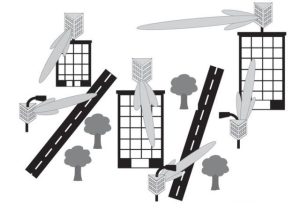Rajada codsiga suurtagalka ah ee milimitirka mowjadda buuxa ee duplex
Millimeter-wave full-duplex waxay leedahay codsiyo suurtagal ah meelo badan, sida raadaarka baabuurta, 5G gacanta, shabakadaha hirarka millimitirka ah, xaqiiqada dhabta ah / la kordhiyay, iyo qaar kaloo badan.
1 shabakada m m m
Alaabooyinka cufan ee sii kordhaya waxay keentay koritaanka deg-degga ah ee taraafikada xogta mobilada, taas oo cadaadis aad u weyn ku keentay awoodda shabakadda. Marka laga eego aragtida nidaamka guud ahaan, Kani waa dhalo dhawaan mana sahlana in la xaliyo.
Qalliinka hoose iyo qarashka dhismaha hoose ee shabakadda ayaa muhiim u ah xiriirka ka dhexeeya 5g goobo yar yar oo unugyo yar iyo shabakado kale. Shaqaalaynta shabakadda iyadoo la adeegsanayo fiber Optics waa mid adag oo qaali ah, Marka waxay ku habboon tahay in lagu isticmaalo cutub kasta oo ka yar 5G.

Milimitir-mowjad (sida shabakadaha e-band) xallin kara dhibaatadan, Bixinta badal dabacsan oo dhaqaale ah oo loogu talagalay shabakadaha 5G. The 60 HZ waxaa loo isticmaalaa isgaarsiinta bilaa-galka ah ee soo galaya ee ka dhexeysa aalado badan, kooxdanina waa la isticmaali karaa iyadoon fasax la'aan. Uplink iyo hoos udhac ayaa isku mar u shaqeyn kara isku mar, taas oo yareyn karta daaqashada shabakadda.
Ilaa dhamaadka, Ele-Pards waxay isticmaashaa laba xargaha oo kala duwan (71-76 GHz iyo 81-86 GHz, oo ay bixiyeen mawjad mawjad ah). Si kastaba ha ahaatee, Qurux-Dunida oo buuxa ayaa ku gaari kara awooddan hal koox oo soo noqnoqda, u dhiganta isku-darka awoodda nidaamka laba milimile-mowjad.
2 m m mowjad-lineplex lineplex
Dhibaatada ugu weyn ee qaba isgaarsiinta wirelililess-milimiless-mowduucyo wireless ah ee is-wareejinta-hoose ee rv-ka-soo-gaadhka 'rf' ee 'rv' ayaa ah in muuqaalka calaamadda ay aad u weyn tahay, iyo yareynta calaamadaynta ee kooxdan-sare ee xadidan ayaa xadidaya masaafada isku xirka wireless. Si loo kordhiyo caymiska shabakadda iyo kordhinta xididdada isku xirka, Xukunka dib-u-dejinta waxaa lagu dari karaa inta udhaxeysa isha isha iyo bartilmaameedka si loo siiyo xiriir deggan oo ku saabsan deegaannada adag.

The Milimitir-Wave-Gravle-Duplex-Duplex waxay isticmaashaa antenna gaar ah oo ka hortag ah anteeno ah oo layaab leh. Antennas la wadaago, wareegga mowjadda milimile-mowjad waxaa loo isticmaali karaa in lagu yareeyo khasaaraha iyadoo la ilaalinayo is-xakamaynta kanaalka.
3 m m m m m mawjad ah radar
Ee ku yaal FM-ka caadiga ah ee RAAR ee Joogtada ah, Waxaa jira dhibaato deg-deg ah in la xaliyo, taasi waa, Baxniintii SI. SI macnaheedu waa in calaamada ay ka soo baxeyso dhamaadka gudbinta waxaa si toos ah u hela dhamaadka hela, taasoo dhalisay khaladaadka cabbiraadda. Antenna interface-ka kuma filna go'doon, ama milicsiga bartilmaameedka u dhow ee ciriiriga ama maqaarka gaariga ayaa sababi doona si.
Soo-jeedinta The-ka si daadashada ah ee soo-daynta dhammaadka la helo ayaa caadi ahaan aad uga xoog badan awoodda awooda bartilmaameedka fog, Marka seenyaalaha waa in la xakameeyaa si looga hortago fadhiyada qaataha. Tikniyoolajiyadda xakamaynta ee SI ee lagu soo saaray asalka milimile-resure-duplex ayaa xallin kara dhibaatada baxsiga calaamadaha SIMAAR ee radar.

Dab-radar-gal-dhaqameed saldhig ah, Antenna la wadaago ayaa la helaa oo la kala qaadaa, iyo isku-darka waxaa loo isticmaalaa gudaha (Khasaaraha fikradda ah waa 3 dB, si caadi 4 dB). Antenna oo aan yaraanin anteeno la wadaago oo loo yaqaan 'anteeno la wadaago'. Beddel.
4 5G Stat Station Station Station
Milimitir-mowjad 5G Station-ka yar ee unugyada 5G ee State Station waxay la xiriiri kartaa isticmaaleyaal badan oo ka mid ah kanaalka ku xiga inta ay isticmaalayaan uplink iyo hoos udhaca, taas oo u baahan adeegsiga tayo sare oo millimile-mowjad oo tayo sare leh oo waa mid culus. Qaab kale ayaa ah in la go'do gudbiyaha iyo qaataha la adeegsanayo tiknilous-your-ka-Dupx

Tusaale ahaan, Khasaaraha si buuxda u hooseeya, go'doomin sare, Wareegtada korantada ee korantada sare ayaa beddelaya durugsan tayada sare ee tayada sare-mowjad si loo gaaro quntooda isku mid ah ee loo gudbiyo oo la helo.
5 Xaqiiqada Virtual (VR), Xaqiiqda Abaalmarinta (Ar)
Bandhigga madaxa-madaxa ayaa awood u leh inuu mashruuc ka muujiyo fiidiyow tayo sare leh (sida 2160 × 1200 qaraar) Isha kasta oo ku jirta heerka sare (sida 90 Hz) si uu adeegsaduhu u la kulmo khibradda dhabta ah ee dhabta ah. Si looga hortago khibrad isticmaale xun (sida dawakh, lallabo, iwm.), Dariiqa fiidiyowga waa inuu buuxiyaa heerar sare (20Gbps) iyo daahitaan hoose (Wax ka yar 5ms).

Si loo helo khibrad dhab ah oo macquul ah, Xaddi badan oo xog ah waa in lagu wareejiyaa gadaal iyo gadaal u dhexeeya kombiyuutarka, madaxa madaxa iyo goobta tracker, taas oo u baahan isgaarsiin laba gees ah. Xisaabta milimile-ka-buuxinta-laba-laba-ka-qubka.
Waxaa intaa dheer, adoo adeegsanaya milimile-mowjad-relx-ka-buuxinta-DUMPLES, Caymiska calaamadaha ayaa loo sii kordhin karaa si loo siiyo isticmaaleyaasha leh dhaqdhaqaaqyo dabacsan oo ka dabacsan.


